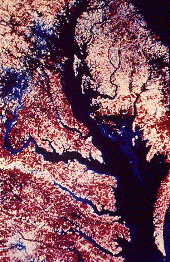



The shaded relief map was produced by Ray Sterner at the Johns Hopkins
University Applied Physics Laboratory. The color-coded AVHRR satellite
image depicts water-surface temperatures from a date in November 1996.
Pictures from Spring 1997 class field trip - Keith Lichtenauer
EVALUATING INTERNET RESEARCH SOURCES
ACADEMY OF NATURAL SCIENCES ESTUARINE RESEARCH CENTER
BayTrippers
- an Online Field Trip to the Chesapeake Bay
EPA
CHESAPEAKE BAY PROGRAM HOME PAGE
Publications
Water
quality
Another site with Bay Program water quality monitoring data
CHESAPEAKE HERITAGE
Contexts for Understanding Bay, Coastal Plain and
Piedmont Natural and Cultural Landscapes
in the Chesapeake Bay Heartland
Chesapeake Bay Watershed
Initiative
Chesapeake
Bay Remote Sensing Consortium
Sea-surface
temperature imagery, Chesapeake Region (Ocean remote sensing, JHU Applied
Physics Lab)
Sea-surface
temperature image - a good one, in case you have difficulty with the
preceding link
Chesapeake Bay
Atlas animated data sets - changes over time
CHESAPEAKE BAY OBSERVING
SYSTEM - data from moored buoys around the bay
Central Applachian
Geoscience Transect Table of Contents
Waterfowl
Reports
from U.S. Fish & Wildlife Service Division of Migratory Bird Management
Duckdata -
Bibliographic database
Return of Bay's
waterfowl hinges on restoration of their habitat
Mallards join
humans in encroaching on black duck habitat
There's no
place like a proper habitat for Bay's waterfowl
Biologists keep
their eyes on the sky for Trumpeter Swan's return
Bald eagle recovery
in watershed on track
Population
goals for 14 Bay waterfowl species met; 7 miss mark
The
exotic mute swan in Chesapeake Bay
Diving
duck distribution, abundance, and food habits in Chesapeake Bay
Benthos
Benthic
sampling program (DNR)
EPA Chesapeake Bay
Program - page on benthos
Benthic-pelagic
coupling
Oysters
General anatomy
of the eastern oyster (from Maryland Sea Grant publication)
Table
of contents - Maryland Sea Grant book on the eastern oyster
Maryland Sea Grant general
page on oysters
Oyster Anatomy Laboratory
Filtering Mechanism Laboratory
VIMS Molluscan
ecology
Nitrogen Dynamics in Forested Watersheds of the Chesapeake Bay.(STAC Publication 97-3). June 17-19, 1997. Co-Convenors: M.S. Castro, K.M Eshleman, R.P. Morgan II, S.W. Seagle, R.H. Gardner, and L.F. Pitelka.
Watershed Response to Changes in Nutrient Loads: The Best Uses of Monitoring and Modeling. (STAC Publication 98-1). May 1997: Co-Convenors: L. Joseph Bachman, Scott Phillips, Thomas Cronin, Don Boesch, Richard Weismiller.
Prospects for Multispecies Fisheries Management in Chesapeake Bay: A Workshop. (STAC Publication 98-002) August 1998; Co-Convenors: E.D. Houde, M.J. Fogarty, T.J. Miller.
Habitat
and Living Resources Monitoring Data Workshop. (CRC
No. 153)
September 1995.
Nutrient Subcommittee-sponsored Research on Nonpoint Sources of Nutrients: 1992-1996. (CRC No. 154)
Increasing
the Access of Minority Institutions to Chesapeake Bay Restoration Activities.
Proceedings of a Workshop 7-8 April 1995. (CRC No. 150c out
of print, available on-line only)
Paula Hill, Dr. Richard Jachowski, and Dr. Harriette Phelps eds.
Chesapeake
Bay Wetlands Research Recommendations and Program Descriptions, March 1993
(CRC No. 150b)
Paula Hill, Steve Nelson, and Pam Mason Eds.
Atmospheric
Loadings to Coastal Areas: Resolving Existing Uncertainties. (CRC
No. 148)
Bruce Hicks, Elizabeth Watkins, and Paula Hill Eds. Feb. 1995.
Tomczak
lecture notes on Shelf and Coastal Oceanography - Flinders University
Ocean
Primary Productivity Study - Rutgers
SeaWIFS
Project - Global Ocean Remote Sensing